Halo fans are picky, like Trekkies. After five Xbox and Xbox 360 video games (soon to be six with the Nov. 6 launch of Halo 4), a comic book series, anime, and eight novels, they have absorbed a huge canon about their favorite sci-fi universe. They have also dealt with the disappointment of a Halo movie by Peter Jackson that never materialized. So it was a little intimidating for executive producers Josh Feldman and Lydia Antonini to begin production on a five-part series that took Halo into a live-action web video series for the first time.
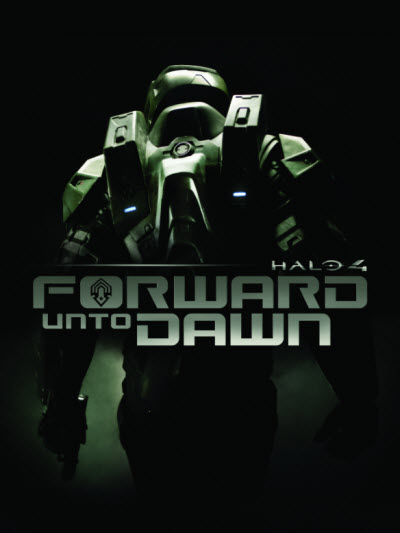 Halo is a multibillion-dollar franchise, and Microsoft’s 343 Industries saw the logic of extending it into other media with the live-action web video series, Halo 4: Forward Unto Dawn. The Forward Unto Dawn story focuses on a small UNSC combat team in training, with the spotlight on the young cadet Thomas Lasky, who has a legacy to live up to but has trouble following orders. The series takes place before the attack of the alien alliance, The Covenant, and its attempt to wipe out humanity. Lasky and his fellow UNSC cadets will make their way to the ship UNSC Infinity, which plays a critical role in the video game.
Halo is a multibillion-dollar franchise, and Microsoft’s 343 Industries saw the logic of extending it into other media with the live-action web video series, Halo 4: Forward Unto Dawn. The Forward Unto Dawn story focuses on a small UNSC combat team in training, with the spotlight on the young cadet Thomas Lasky, who has a legacy to live up to but has trouble following orders. The series takes place before the attack of the alien alliance, The Covenant, and its attempt to wipe out humanity. Lasky and his fellow UNSC cadets will make their way to the ship UNSC Infinity, which plays a critical role in the video game.
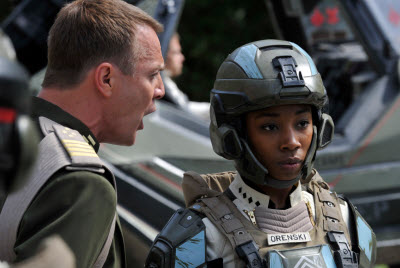 Feldman and Antonini have a history in making digital films; Feldman worked at Tom Hanks’ Playtone and helped make the Electric City sci-fi animation series, released on the web. Antonini made digital films for Warner Bros. and helped create the Mortal Kombat live-action series.
Feldman and Antonini have a history in making digital films; Feldman worked at Tom Hanks’ Playtone and helped make the Electric City sci-fi animation series, released on the web. Antonini made digital films for Warner Bros. and helped create the Mortal Kombat live-action series.
The series is part of a Halo 4 promotional campaign that began with the first episode’s release on Oct. 5 on Machinima and Halo Waypoint. Episode 4 debuted today. Here’s an edited transcript of our interview with Feldman.
GamesBeat: Halo’s fans are pretty hardcore. They know their canon and all the lore backward and forward. Was it hard to make this without tripping over anything?
Feldman: Speaking only for myself, on one level I was scared shitless. But on another level, it’s the best motivation for getting things right. It’s a great reason to stay vigilant. Credit where credit’s due, we tracked the story with 343. There was a 343 representative, an expert, on set with us every day.
GamesBeat: Tell us about your history in making web films.
Josh Feldman: Before Halo, I worked for Playtone, which is Tom Hanks and Garry Goetzman’s production company in Los Angeles. I was lucky to have the opportunity to work on a project there called Electric City, which was a science fiction animation series, an original idea of Tom’s. I got to develop that with him. That was Playtone’s first big digital project. It was a great thrill to work on something that had a depth of storytelling and took advantage of what the online landscape can do. During my time there, we really embraced digital. It was a great place to be to dip your toe in those waters.
Then, through a series of interconnected events, I wound up working alongside Lydia Antonini as executive producer of Halo 4: Forward Unto Dawn.
GamesBeat: What kind of lessons did you apply from the Yahoo Electric City project?
Feldman: In some ways, it’s a lesson that I got from my time at Playtone in general. You have to be true to the story. As obvious as that sounds… You should embrace the format, but that is secondary to being true to the story, and not having an apologetic disposition just because something is being created initially for a digital distribution process. It was a great thrill, and I consider myself very lucky to have had mentors in Tom and Gary. If there’s one thing they preached, it’s that you have to be true to the story you’re telling.
GamesBeat: Halo was almost a movie as well. There’s a lot of history to the possibility of moving it to a new screen.
Feldman: Right. The amazing thing about Halo — and this was one of the greatest thrills when I first got to meet the folks from 343 Industries — is how much mythology there is. It’s such a fertile landscape. It knocked my socks off that there’s as many storytelling possibilities… Not just in terms of what gamers would expect, casual players of the game, but hardcore fans that are loyal and discriminating and know so many different avenues. That was daunting, admittedly, but incredibly fun, to realize that this can absolutely work in a 90-minute live-action vernacular.
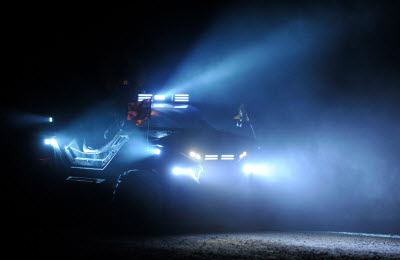 GamesBeat: How did the decision get made to do the live action, and why do it as live action?
GamesBeat: How did the decision get made to do the live action, and why do it as live action?
Feldman: 343 knew this was going to be a big year for Halo in general, because of Halo 4. They looked at the landscape and knew that they wanted to do something big. They saw some other examples, potentially, of how other brands and IPs have tacked into the new media formats, so to speak, to make a splash. But I think beyond that… We should remember that Halo has already been realized in a variety of different formats. Obviously it’s incredible games, but it’s also a series of New York Times bestsellers, comic books, consumer products. They’re no strangers to working with different people who produce, write, and create in other formats.
In some ways, this was an extension of what they already do so well. In other ways, this was new and different. You asked about live action. Of course there are the commercials, amazing commercials. They’re movies unto themselves. Halo and live action already go together, with great results. The fact that this project is live action speaks to what live action does best, and that is, we get to introduce a series of characters, one in particular among them being Thomas Lasky.
This is something that, working with 343, we’re very proud of. We have a character called Thomas Lasky who’s introduced in Forward Unto Dawn. We meet him with all of the baggage that he has and the demons that he’s haunted by and the obstacles that stand in the way of becoming the hero that we hope to see him be. Thomas Lasky then lives on in the game, Halo 4, and beyond. In some ways it’s a fun experiment. We introduce a character in the way that live action can, creating the most compelling emotional connection. Then we see that character live on in the franchise. It’s a pretty exciting new approach.
GamesBeat: There is that huge universe in Halo with a giant war going on, but what’s always been interesting about Halo is this story that develops between Master Chief and Cortana. There’s always some kind of emotional center there. Did you think of Forward Unto Dawn in the same way? That you wanted something a little more intimate than just this big gigantic war?
Feldman: Sure. To take your example specifically, with the Chief and Cortana, we think fans have been enjoying their sequences that open each episode, on the damaged Forward Unto Dawn ship. It was an opportunity to explore Cortana’s rampancy, which hadn’t really been touched on yet. It gave Cortana almost a stage on which to express what happens when an AI is stranded for that many years while the Chief is in cryo-sleep. It was an extension of exactly what you’re talking about.
We can take virtually no credit for that, though. We’re plugged into 343’s narrative master plan for those sequences. They are the literal bridge between Halo 3 and Halo 4. Those pieces came out really well. Fans seem to be enjoying them. But this series was absolutely an opportunity for, as you put it, intimacy. You get to spend some time with characters that are in the UNSC military academy, and you get to see the expectations, the pressures, and the demands that are placed upon adolescents in this world.
When we first meet them, it’s during the Insurrectionist War, which is really fascinating. That’s an aspect of the Halo mythology that hasn’t been explored visually. We get to drill down on this very unique timeframe that hasn’t been explored as much as other areas of Halo. Then, within the same 90-minute narrative, we get to dive right into the human-Covenant conflict. The series demonstrates the transition from one theater of war to another. But what we get is a very intimate point of view, through the eyes of these impressionable teenagers that are on the verge of adulthood, on the verge of forging their identities. That creates some really compelling landscapes to tell a personal story, with the backdrop of these huge, epic, world-changing events.
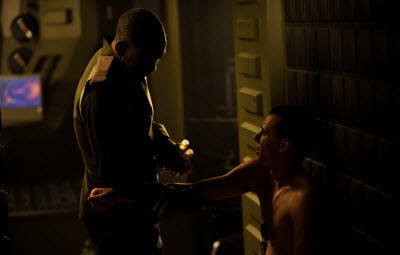 GamesBeat: You have some very young actors here. It’s interesting that the Hunger Games came out before this. Was there any influence from thinking about that?
GamesBeat: You have some very young actors here. It’s interesting that the Hunger Games came out before this. Was there any influence from thinking about that?
Feldman: Well, to answer your question, there was no direct decision to be a derivative of Hunger Games. We were already well under way before Hunger Games came out. What I would say is that there are so many examples in literature of characters at an impressionable age facing adversity. Hunger Games is a fantastic story, but it’s another entrant into an area that has no lack of exploration, having young characters facing odds.
The reason that works so well is because it’s relatable. These kinds of stories do often take a fantasy or science fiction setting, where young people are dealing with trials and tribulations on an exaggerated level . On a daily basis, we may not be involved in heavy combat, God willing. But young people are constantly thinking about who they are and what they’re supposed to become and what expectations are placed on them by outsiders. There’s a relatable aspect there.
That’s the great thing about Forward Unto Dawn. We introduce a bunch of different young cadets, each with their own personalities. You have a very relatable emotional story. On another level, though, you have all the requisite action and suspense that fans expect from Halo.
GamesBeat: The first few episodes are out now. Is there anything that some of the hardcore fans are paying attention to? I don’t know if there have been any revelations that have happened so far, but is there anything they’re talking about a lot in the community?
Feldman: They’ve noticed some fun things like the cameo by Frank O’Connor (head of Microsoft’s game studio 343 Industries), which I think they really enjoyed. They’re looking at the timeframe and determining what that means. This is an era that deals with the Insurrectionist War. We’ve made no secret that this will deal with the beginning of the Covenant War. I think fans are piecing together where this fits in the greater mythology. I can say that, by virtue of the collaboration with 343, this definitely does fit into the larger whole.
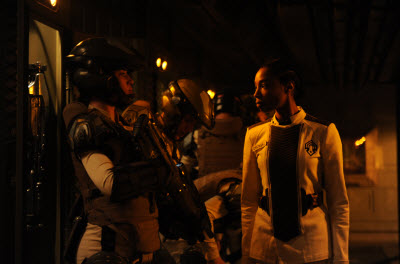 GamesBeat: How did you get selected for this? Did you have to make a pitch to the 343 folks?
GamesBeat: How did you get selected for this? Did you have to make a pitch to the 343 folks?
Feldman: We did a pitch, yes. Lydia Antonini, who’s my fellow executive producer, had been involved in a Mortal Kombat digital series. Purely from a business standpoint, Microsoft was interested in talking to her. Lydia brought me to the project. That’s how I got involved.
You could call it a pitch, or you could call it a brainstorming session with 343. We basically explained what we would do and what it would look like. We traveled with our director, Stewart Hendler, up to Microsoft on numerous occasions and laid it out. The vision is shared between us and 343. This wasn’t a situation where they wrote a check and said, “Come back when it’s done.” This was hand in hand.
That was one of the ways that we were able to pull it off within the time frame, and to your earlier question about authenticity, while still making sure that the fans saw what they hoped for and expected. We had to keep this thing accurate. This is not a separate vision or version of Halo. This is absolutely part of the canon and very much part of the narrative roadmap that 343 has created. We were stepping into their sandbox, but it was a great thrill to be there.
GamesBeat: I guess you’ve heard about the video game movie curse. You’re probably very aware of that while you’re making this as well.
Feldman: I was kind of waiting for someone to drop the house on me. [laughs] It goes back to the fact that we did do this in such a collaboration with 343. That helped dispel any of that feeling of, “Well, we’ll just be this band of outsiders and do it our own way, fan reaction be damned.” That wasn’t the way we approached it.
I’m not implying that that’s how all of the filmmakers who make video game-based movies approach things, but we were never even in a situation where we could find ourselves worrying if we were veering away from authenticity. This was completely created with 343. The credit really goes to them. What we were able to do is bring our expertise with characters and storytelling and live-action production.
What I’m most proud of is that you have a great character-driven dramatic story, and then layered on top of it you have all the things fans expect from Halo. It works in that dual way. If you’ve never played a game of Halo, you’ll be able to come to Forward Unto Dawn and hopefully be very engaged. If you’re a die-hard fan, you’ll hopefully be delighted by the mythology that’s baked into this project.
Like so many things in filmmaking, success takes a healthy amount of luck, but to the extent that we had a formula for what you’re describing — getting around the game-movie curse, if there is one — it was that duality. Embracing people who have never played the game, or casual gamers, and the hardcore as well, in an authentic way.
 GamesBeat: You’ve got five million views on YouTube for the first one and almost three million for the second one. What do you think of this new medium now?
GamesBeat: You’ve got five million views on YouTube for the first one and almost three million for the second one. What do you think of this new medium now?
Feldman: Isn’t it great? Just to know that millions of people are looking at something you worked on, it’s a thrill. Forward Unto Dawn has a very unique and purposeful distribution plan. First it exists in its episodic form with these five episodes, doing the numbers you’ve just mentioned. Then it’s a long-form piece that’s part of the Halo 4 limited-edition set. Then it’s a best-in-class Blu-ray and DVD with tons of additional materials that fans are going to hopefully love.
Any opportunity to increase the ways that you can get your project in front of the fans is a good thing. Each of these different windows has its own capabilities. When these episodes go out online, they’re immediately received in a forum where the fans can start to debate and discuss and compare and re-watch. That’s really cool, because that promotes the kind of…what I’ll call a water-cooler mentality. Any filmmaker would hope to have that. You make something to be seen and to be discussed and analyzed. So the digital venue promotes that.
Later windows are more on the side of exploring the presentational quality, of a Blu-ray for instance. You get to experience it in the 5.1 sound and all the fidelity that format brings. Each of the windows has its own unique attributes. That’s really exciting.
GamesBeat: Where do you hope to take this next? Is there some hope that you could do more episodes, or maybe move on to another movie?
Feldman: As far as this particular project, that’s a question for 343. It’s been one of the greatest thrills to get to spend the last year wading deep in the mythology. If there’s one thing that I can say for certain, 343 is not going to stop innovating. They’re not going to stop pushing the technological boundaries of how they can tell the stories that come out of the Halo universe.
Whether or not I get to be involved in that… If I’m only a fan, I look forward to what they come out with next. If I get to be involved, that would be great. I’ll say that 343 is a smart group of people. They respect their fans enormously. If there’s one thing I would bet on, it’s that they’re not stopping any time soon when it comes to figure out the latest and greatest way to engage in storytelling.
GamesBeat: Did you get to play Halo 4 yet?
Feldman: I got to see a little bit of it. [chuckles] They have outdone themselves. It’s so visually dynamic. I can’t wait to play it and to see the rest of it. As I mentioned, we have some links betweeen what we did here and the game, so from a production standpoint, it was important to understand what that handshake is between our series and the game. But just as a fan of Halo, it looks pretty awesome.
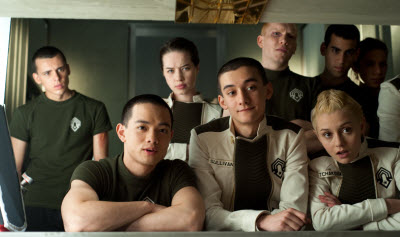 GamesBeat: What are we going to look forward to in the next episode here?
GamesBeat: What are we going to look forward to in the next episode here?
Feldman: Episode four comes out Friday (today). When we left off at the end of episode three, we saw the beginning of the Covenant invasion. That’s going to continue, and it’s pretty intense. We’re all on tenterhooks because we think we’re getting to the episodes that are going to really deliver everything that the fans of the game are going to love. We’re getting into some pretty wild action.
GamesBeat: Is there anything else you’d like to talk about?
Feldman: It’s been a once-in-a-lifetime experience to work on something like this, that we put together so quickly. When you dangle the Halo name on a hook, suddenly a lot of people come out to see you. We had an amazing crew. Stewart, our director. Kasra Farahani, our production designer. We had Legacy Effects, the company that builds all the suits for blockbuster movies — they built the Iron Man suit — to do our Master Chief suit. We had so much top-tier talent, because everybody was so excited to be part of what is the largest extension for live-action Halo.
I hope I’m lucky enough to have a year like this one again, where everybody was so committed to the final product. People often congratulate me and compliment me, but I’m just saying thank you on behalf of the people who really deserve it, and that’s our whole crew.
VentureBeat's mission is to be a digital town square for technical decision-makers to gain knowledge about transformative enterprise technology and transact. Learn More

